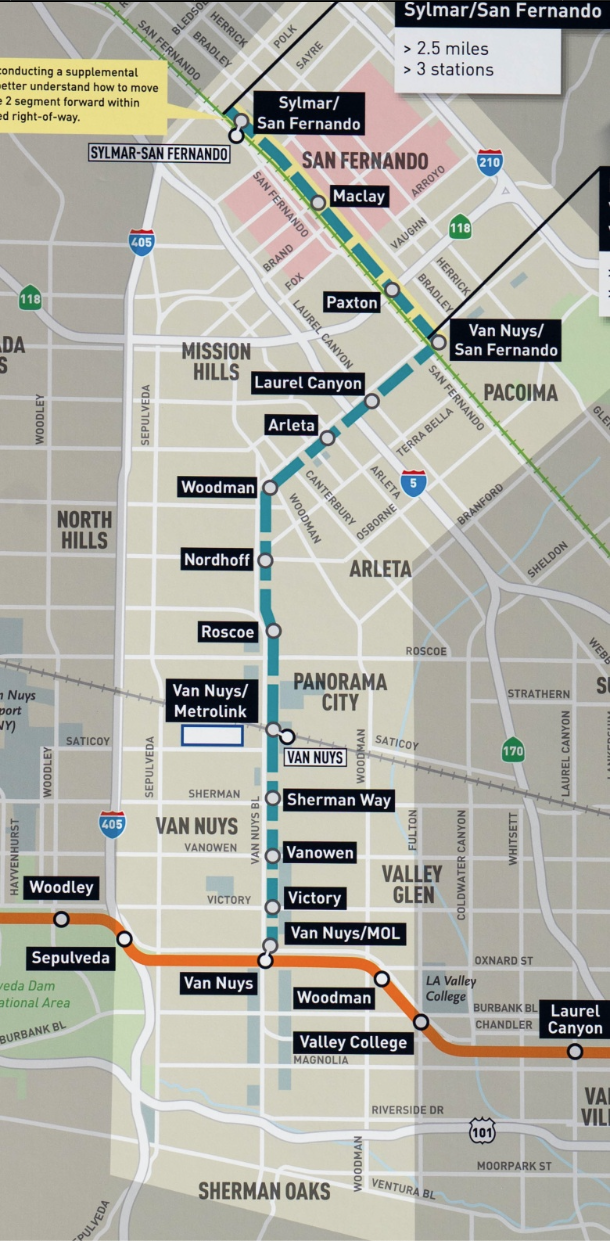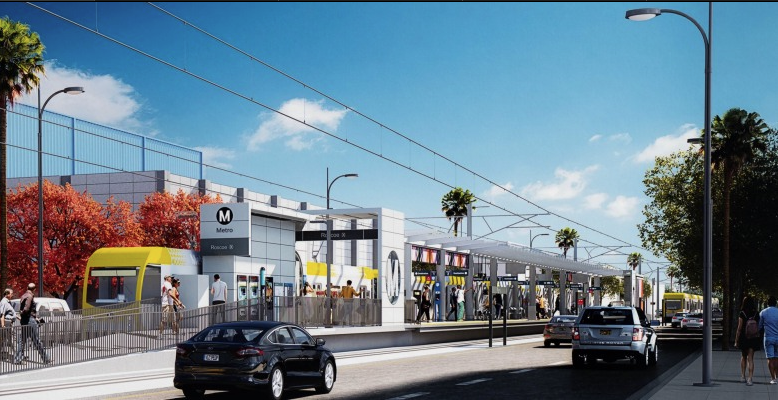Rep. Cardenas, Metro CEO Wiggins, tour route of future East San Fernando Valley rail line
Rep. Cardenas, Metro CEO Wiggins, tour route of future East San Fernando Valley rail line They say $3.7 billion cost is worth it, bringing modern transportation to majority-minority Valley area
Rep. Tony Cardenas exited the bus that traced the route of a rail line planned for Northeast San Fernando Valley on Monday, June 26, and walked over to a strip mall on Van Nuys Boulevard in Van Nuys.
He pointed to a map showing the future stops of the East San Fernando Valley Light-Rail project,his finger aimed at Pacoima. “That is where I was born,” said the Democratic congressman to officials joining him on the tour, which included many officials from the project sponsor LA Metro including CEO Stephanie Wiggins, and members of local neighborhood councils and the media.
When told the line would cost $3.7 billion to build and take at least 10 years to complete, he glanced at the thoroughfare packed with cars and the sidewalks jammed with people walking or getting on and off the local bus that barely moved in snarled traffic.
“This is a neighborhood of hard-working people,” Cardenas said, with many emigrants from Mexico, the Philippines, Central America and Russia. “A lot don’t have cars. So what do they do? They take public transit. So we need to give them a dignified way to get to and from work and to take their children to school.”
Indeed, one of the most expensive and ambitious transit railways is Metro’s 9.2-mile light-rail project, which would extend north from Van Nuys Boulevard and the G Line (Orange) station to the Sylmar/San Fernando Metrolink Station, and would add 14 light-rail stations. The first phase would stretch 6.7 miles down the middle of busy Van Nuys Boulevard to San Fernando Road, while a second phase would travel 2.5 miles alongside the Metrolink heavy rail line into San Fernando.

The project would be the first light-rail line in the San Fernando Valley since the Pacific Electric Red Car stopped operating in 1952. Cardenas, along with U.S. Sen. Alex Padilla, D-CA, also from Pacoima, have worked together to provide more than $1.5 billion in federal dollars for the project, and Cardenas said more is on its way.
“Several billion dollars sounds like a lot of money. But when you look at the infrastructure across America, it is in the trillions,” Cardenas continued. “And now we are finally getting our fair share.”
On Jan. 31, 2023, the project received a $600 million grant from the state Transit and Intercity Rail Capital Program (TIRCP). It was the largest grant awarded in that cycle in the state of California.
In May 2022, the Federal Transit Administration announced it would provide the project $909 million over two years for construction. The money is part of the FTA’s Expedited Project Delivery Pilot Program.
President Joe Biden is ready to include another $250 million in infrastructure dollars for the ESFV project, said LA Metro spokesman Dave Sotero.
Eleven new stations are planned for the first phase, which will connect the majority-minority communities of Van Nuys, Panorama City, Arleta and Pacoima with their first modern light-rail system. Some destinations along the line include the Van Nuys Civic Center, the Panorama Mall, multi-residential housing in Van Nuys and Arleta High School.

The first phase is expected to be built by 2030. The project broke ground on the first segment in December 2022 with preliminary design and utility relocations continuing this year. The second phase will require Metro’s project to share space with the heavy passenger-rail service Metrolink, a difficult feat. That alignment is being studied separately, with a report expected in mid-2024.
Because the communities along the corridor are majority Latino, it is critical that Metro communicates the project route, scope and also what will be about seven years of major construction that will entail road closures and disruptions to businesses along the route, Metro reported.
So far, the folks Cardenas has talked to from the region fall into two categories, he said.
“The two main things is hurry up, from a part of the community who uses public transportation. And the other part of the community is getting nervous about it, saying what kind of disruption will it be,” he said.
In late February, LA Metro approved $31 million to broaden early construction and conduct community engagement discussions with residents and businesses. The money from Metro included approval of a contract with San Fernando Transit Constructors (SFTC), a joint venture of Skanska USA Civil West California District, Inc., and Stacy and Witbeck, Inc.
The effort includes a “cultural competency” aspect with the goal of reaching out to 20 community groups to explain the light-rail project, construction closures and other issues.
Cardenas said outreach efforts must be in English and in Spanish. “You will run into small business owners who prefer to speak in Spanish. And if you speak Spanish, they will be more understanding and more accepting of change,” Cardenas said while riding the bus on Van Nuys Boulevard.
Wiggins was asked about past efforts to keep businesses afloat during construction of the K (Crenshaw) Line, particularly in the historic Leimert Park neighborhood. The K Line opened In October and cost about $2.2 billion. Metro heard from businesses that were disrupted during the lengthy construction and started a business interruption fund.
“If the K Line is any indication, over 80% of the businesses who received a business interruption fund grant from us were still in business when we opened,” Wiggins said on Monday.
There are more businesses along the ESFV light-rail line than along the K Line, the Regional Connector and the D (Purple Line) extension combined, Metro reported.
Cardenas said the businesses will flourish because they’ll have additional customers from the train.
Metro has set aside some capital funds from tax measures M and R and some state monies, but the cost of the project continues to grow and the amount of the funding gap remains uncertain.
“Build it and they will come. The Orange (G Line) in the San Fernando Valley got up to capacity literally overnight and literally got beyond that capacity,” Cardenas said. “I think we will see that here, on the line going through the Northeast Valley.”
By: Steve Scauzillo
Source: Los Angeles Daily News
